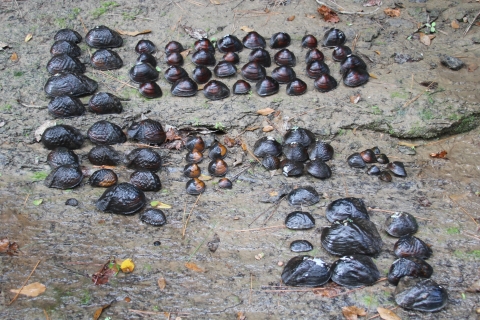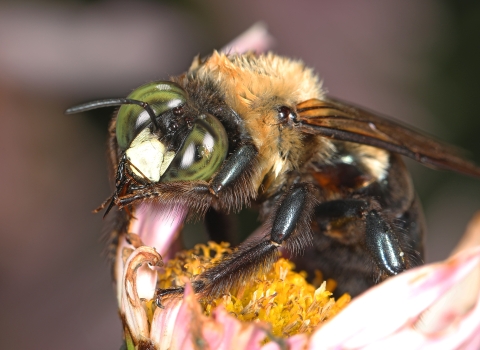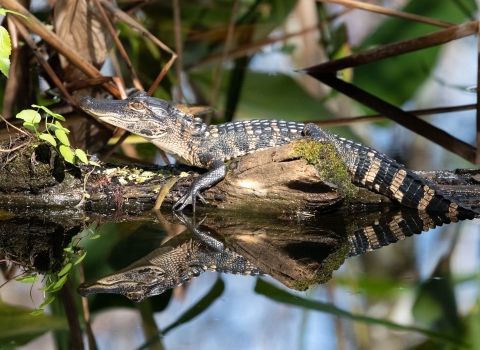Crouching in the waist-deep, murky water, two biologists dig into the streambed and scoop up handfuls of freshwater mussels. Before placing each of the slick shells in their bag, they turn them over in their hand and run their thumbs across the top, feeling for the subtle textural features that help tell the species apart.
This field trip to Lake Fork Creek, a tributary of the Sabine River in East Texas, gives a glimpse of the watershed’s biodiversity that most casual passersby don’t get to see. In just a few minutes, the biologists have collected a staggering assortment of native freshwater mussel species from the small section of the creek, including mussels known as maple leaves, bank climbers, and bleufers.
While the biologists count and measure the mussels as well as collect their genetic information, a cargo train rumbles over a tall bridge crossing just upstream of where they are, following a track through the dense forest. It’s a reminder of the industries the Sabine River Basin has supported in East Texas – forestry and railroads – and the types of activities that wildlife in the watershed have lived alongside over the last several hundred years.
Starting in the early 19th century, the Sabine River was utilized over a greater distance than any other river in Texas, carrying heavy traffic of commercial cotton and timber on rafts, flatboats and steamboats hundreds of miles from north of Tyler all the way to the Gulf of Mexico. In the last hundred years, railroads eliminated most of the commercial boat traffic on the river, but the dense pine forests that line its banks continue to support a thriving timber industry today.
Through it all, the natural resources found in most areas of the river basin have not only persisted but flourished. When asked what makes the Sabine River Basin so special, both scientists use the same word to describe it: “wild.”
“Part of it is that you feel like you have this place all to yourself… a secret that nobody else knows,” said Luke Sanders, field biologist with the Sabine River Authority (SRA). “When we're on the river we rarely see another boat all day. It’s still very much a wild place.”
“You can see just about anything – alligators, waterfalls, we’ve certainly got our share of eagles,” said Bill Kirby, SRA Natural Resources Management Director. “Large swaths of East Texas are pretty wild. It’s pretty neat.”
A float on the Sabine provides visitors with views of a variety of wildlife flying and hiding among the hardwood-lined banks. Below the surface, the river basin sustains more than 100 native fish species.
But not all species that call the river home are found in great abundance. Though the team finds a wide variety of mussel species, two species state-listed as threatened are noticeably absent: the Texas heelsplitter and Louisiana pigtoe. Each of these species, along with the alligator snapping turtle and western chicken turtle, is considered “at risk” and potentially in need of federal protection. We at the U.S. Fish and Wildlife Service are currently reviewing the Texas heelsplitter and Louisiana pigtoe for potential listing under the Endangered Species Act (ESA).
In the Sabine River Basin, few are more familiar with the ins and outs of the watershed than the Sabine River Authority. Since the Texas Legislature established it in 1949, SRA has been committed to protecting the basin’s waters and maintaining the integrity of the ecosystem “for mankind and wildlife alike.”
“We take ownership of the resource and we've got high interest in the integrity of that resource and anything that's going on in the basin,” Sanders said. “We want to provide the cleanest, best product to our customers, and that goes hand in hand with wanting the water quality to be as good as possible. It's our livelihood…no one cares more about it than we do.”
In the last five years, when the Service started reviewing the alligator snapping turtle and several freshwater mussel species for a possible ESA listing, a coalition of local stakeholders came together to form the East Texas Initiative. Through initiative meetings, led by the Texas Comptroller’s Office Natural Resources Program, the SRA started to discuss how they could assist with conservation efforts for at-risk species.
“At that point, our general manager and several of the biologists began talking about it and asking ‘What does this mean for the river authority? And how can we help?’” Kirby said. “Our mission is to conserve and protect the waters of the Sabine River Basin. We don’t just sell water…native species conservation is a part of that. We take that role seriously.”
In Texas, some wildlife species have been counted and documented by researchers for decades. But until recently, freshwater mussels such as the Texas heelsplitter and Louisiana pigtoe “just haven’t received that level of attention.”
“When you're looking at evaluating the status of the species, it helps to have long term population trend data,” said Erik Orsak, supervisory biologist with the Service. “If someone had been looking at the abundance and distribution of these mussels for decades, we could plot a chart showing whether it was going up or down or flat. We don't have that for the East Texas mussels.”
This year, SRA’s Natural Resources team has taken the initiative to study the mussels and supplement the available data on their distribution and abundance in the basin.
“We really believe that improving data that is out there on the front side of the curve is one of the most important things that can be done,” Kirby said.
Unlike early naturalists, whose mussel exploration work generally consisted of walking along the banks of rivers collecting empty shells, modern researchers use structured methods to ensure they are doing unbiased sampling. In the Sabine River, the team is surveying 30 sites in the upper Sabine River basin and 15 sites below Toledo Bend Reservoir. The process includes measuring and marking 150 square meter plots, within which every mussel found in a specified amount of time is collected, counted, and measured, with selected species sampled for genetic information.
“We're looking at population abundances and distributions and we're trying to make habitat associations so we can understand the species better,” Kirby said. “We are also working on a whole genomic approach…that will allow us to make inferences on genetic drift between populations, maybe upstream and downstream of Toledo Bend, or even in between basins.”
Despite hauling up hundreds to thousands of mussels of a variety of species at certain survey sites, the Texas heelsplitter and Louisiana pigtoe remain elusive.
“We're not just pulling them up by the handful,” Kirby said.
Why some native mussel species are present in East Texas rivers in large numbers and the Texas heelsplitter and Louisiana pigtoe are not remains an unanswered question for now, but SRA hopes the data they are collecting will help researchers get closer to an answer and guide conservation and recovery efforts down the line.
“The biggest hope is that management decisions will be based on sound data and not a lack of data,” Kirby said. “If they're imperiled, we'd like to be a part of the solution…We want to be good stewards, and we want to do what we can to strike a balance between the needs of man and the needs of nature.”
While mussels can be difficult to find, hiding among rocks and gravel in the streambed, alligator snapping turtles are a little easier to locate. In East Texas, the turtles are notorious for stealing game fish off a trot line or getting snagged on a fishing hook after getting a little too hungry for an angler’s cut-bait.
During East Texas Initiative meetings, Texas Parks and Wildlife Department herpetologists and other researchers studying the alligator snapping turtle brought up a similar concern that others had with the mussels – they just don’t know how many are around or where exactly they are. Once SRA found out there was a need for more data about the species, they found a creative way to help fill those gaps.
“This is something we can do to help, and it’s pretty easy,” Kirby said. “We said, ‘Let's put up some signs to educate the public and let them know that alligator snapping turtles are protected in the state of Texas by law. And two, let’s ask for people to tell us where they're seeing these turtles and submit a photo. And then we can start to help point researchers in the right direction.’”
It wasn’t long after SRA posted 50 signs near boat ramps with the question “Have you seen this turtle?” that the notifications and photos started rolling in.
Once SRA receives the photos, they upload them to a geographic information system (GIS) map monitored by the researchers studying the elusive turtles.
Since the citizen-science project started, Kirby said other river authorities in East Texas have joined the cause, with the Lower Neches Valley Authority building out the GIS layers used for the data collection and critical endangered species surveys.
“It’s another way to increase transparency and communication between agencies,” Kirby said. “I think it’s awesome that other people are willing to see the value in it and also start that public information and outreach.”
While a major focus of SRA’s at-risk species conservation efforts are those species that are currently under review for a potential ESA listing, they are also looking ahead at others that may be evaluated in the next five to 10 years.
“We're looking ahead…so that we can kind of see where things are going and where the research gaps are so that we can help where we can, whether that’s with mussels, snapping turtles or [western] chicken turtles coming up,” Kirby said.
Through discussions with the Texas Comptroller’s Office, Kirby said SRA came to realize that another cryptic species, the western chicken turtle, is on the horizon as a candidate for ESA listing.
This year, SRA made a call to researchers at the University of Houston to find out how they could assist them in documenting the species’ known distribution and habitat across Texas. After learning they needed maps of SRA-owned properties to determine if those areas could be surveyed for western chicken turtles, Kirby said not only did they provide GIS information and land access to the researcher, they also reached out to other East Texas river authorities to join the cause.
“How easy was that? It didn't cost a dime,” Kirby said. “I think [the researcher] was somewhat overwhelmed with the amount of response she got. The river authorities of Texas want to do good, we want to help researchers and we want to help the Service make good decisions.”
For Service biologists working with at-risk species in East Texas, having strong partnerships with river authorities and other local stakeholders goes beyond just collecting data.
“We are so pleased to be working with the river authorities on at-risk species conservation in East Texas,” said Debra Bills, Project Leader for the Service’s Arlington Ecological Services Field Office. “They are really well informed about the land, they understand the local issues and local resources, and they have a lot to contribute to our effort.”
“We're on the same team,” Orsak said. “When you're out there protecting water quality and ensuring the flows are adequate for wildlife, it is providing a service for humans as well, for recreation, for fishing, canoeing, kayaking and drinking water supply.”





